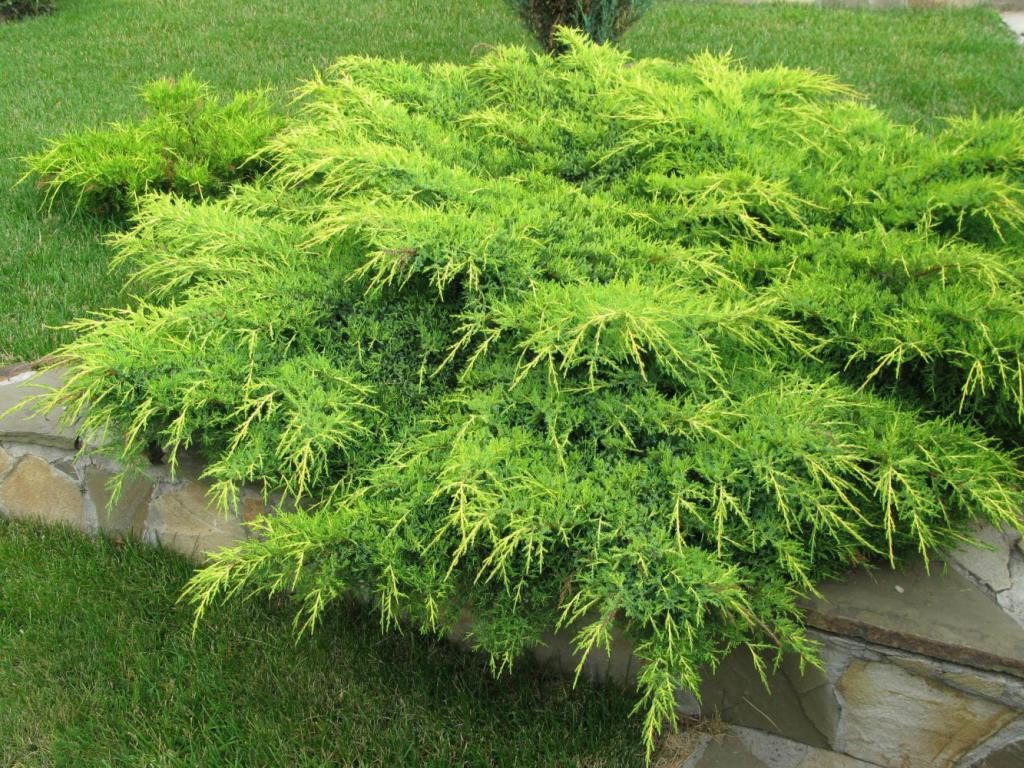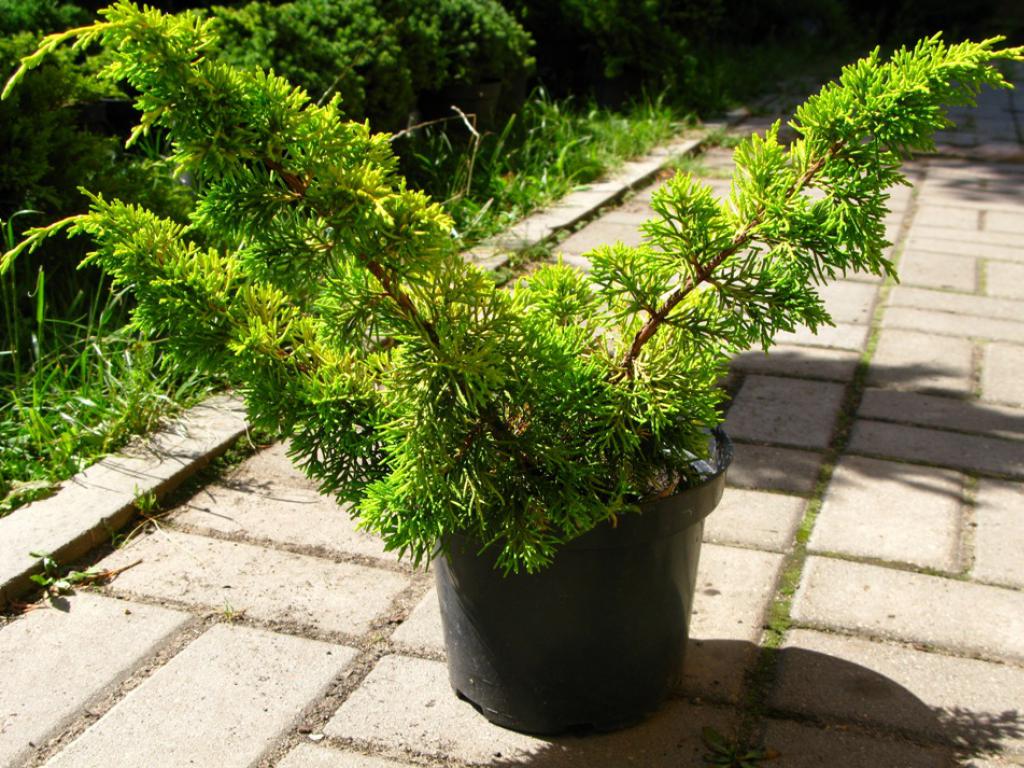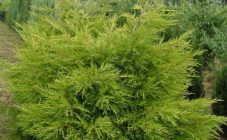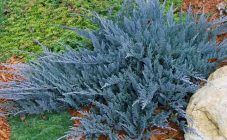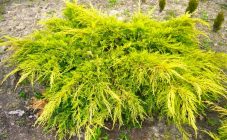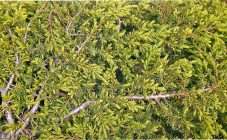Juniper Pfitzeriana is a perennial plant. Gardeners love it for its unique look and phytoncides that the plant releases into the environment. These substances cleanse the air from many harmful bacteria. In addition, the shrub easily tolerates even polluted city air, so it easily adapts to any living conditions.
General information about culture
The Pfitzeriana juniper was born in 1890. In Germany, Wilhelm Pfitzerian crossed two species - Kozatsky and Chinese, as a result of which this new shrub appeared.
The tree belongs to coniferous representatives. It has lush arched branches, which are covered with soft needle-like needles with scales. Plant height reaches 1.5 m and width - 3 m. With its wonderful green color, Pfitzeriana will delight those around you all year round.
This juniper includes several different species, which have their own characteristics, although they are very similar in description to each other.
The most popular among them are:
- Glauka;
- Aurea;
- Gold Coast;
- Compact.
Juniper Pfitzeriana Glauka is distinguished by its gray-green or silvery shade. In width it can reach 4 m. The crown itself is very branched. The main advantage of this species is that it is suitable for any soil, and it easily tolerates heat.
No less interesting is the Pfitzeriana Aurea juniper, which is a fast-growing plant. A tree can grow by 20 cm per year. In general, its height reaches 3.5 m, and its width sometimes reaches 5 m. A distinctive feature of the species is the ability to change color. Summer green color in winter is replaced by a yellow-green tint. It is worth noting its resistance to frost and spring burns.
The next equally popular type is the Gold Coast. Unlike the Pfitzeriana Glauca juniper, as well as other representatives of this species, it is a short shrub. Its height is barely one meter. In addition, the Gold Coast is growing very slowly. Its distinctive feature is its golden-green-yellow color.
And finally, the Compacta juniper. The height of this shrub barely reaches 80 cm, and the width is 2 m, therefore it is considered a compact plant. The tree looks great on terraces and rocky slopes. The shrub has a gray-green tint. In addition, this species tolerates shade well and is not whimsical in relation to the soil.
How to plant a plant
The plant is propagated by cuttings and layering. As cuttings it is best to use spring shoots with a length of about 12 cm. But the layers that are taken from April to July take root best of all.
In order for the average Pfitzeriana juniper to take root and fully develop, you must adhere to the planting rules:
- A shrub is planted in a sunny area.
- The distance between the bushes should not be less than half a meter, it all depends on the type of juniper.
- It is necessary that the size of the planting pit is 3 times larger than the earthen lump.
- The bottom of the pit is sprinkled with sand and broken brick. The thickness of such a drainage layer should be about 20 cm.
- The pit itself is covered with a mixture of peat, sand and sod land in a ratio of 2: 1: 1.
- Also, during planting, a growth stimulator is also introduced. In this case, Kornevin proved himself to be excellent. For 1 tree, 2-2.5 liters of this product should be used.
- After planting, the shrub is watered abundantly for a week.
Care features
Pfitzer's juniper is not at all demanding in care, so you will not have to spend a lot of time growing it.
- The shrub needs rare but abundant watering. If possible, you should install automatic watering. It is categorically not recommended to water the plant during hot times of the day, it will only harm it.
- Young seedlings require loosening of the soil.
- As for feeding, there will be no problems with it. Juniper is fertilized once a year at the end of April or at the beginning of May. It is not worth making organic fertilizing, as they will make the shrub more susceptible to a variety of diseases.
- For the winter, the plant is covered with a ten-centimeter layer of peat, and young plants are covered with spruce branches. Cone-shaped varieties need to tie the branches to the trunk, otherwise they may not withstand the snow falling on them.
- You need to be careful with pruning, since sanitary is needed for all types, but uniform pruning is required only for some of them.
Common diseases and pests
If you strictly adhere to all recommendations, the tree will grow healthy. But still, there are times when it succumbs to certain diseases. Most often, this shrub suffers from diseases such as:
- shute brown;
- rust;
- drying out of branches.
Schütte brown is a very dangerous disease. The word "schutten" comes from the German language and in translation means to crumble. And this is really so, in affected plants the needles first turn yellow, die off, and then crumble. The fact that the plant is sick is indicated by the brown-brown shade of the leaves, which appears on them in early summer, and after a while black dots form.
Weak shrubs are susceptible to this disease, as well as those that grow in excessively wet soil, or in the shade.
To overcome the brown shute, it is necessary to cut off all damaged branches, remove the foliage and treat the shrub with such a means as Quadris, or Strobi.
The next no less dangerous disease is rust. Its causative agent are basidiomycetes. The affected plant is characterized by a swollen stem, on which bright orange growths form over time. Rust is dangerous not only because it spoils the aesthetic appearance of the shrub, but can also lead to its death.
Rust is easier to prevent than to cure. Therefore, for reassurance, it is necessary to process the plant several times with Vectrom or Bayleton.
The shrub can lead to death and the drying of branches, the causative agent of which is a variety of pathogenic fungi. The cause of this disease is a thickened planting and heavy soil. The affected branches are cut off, and the shrubs are treated with fungicides such as Skor and Tilt.
As for pests, juniper scale insects and moths, as well as aphids and mealybugs like to feast on shrubs. Actellic, Angio, Caesar and Aktara have proven themselves well in the fight against these parasites.
If it is necessary to diversify the landscape near the house, or the task is to decorate the whole park, then you should definitely pay attention to the Pfitzerian juniper. It looks good against the background of pines, firs and spruces. Of course, juniper, together with flowering shrubs, will change the landscape design beyond recognition.
